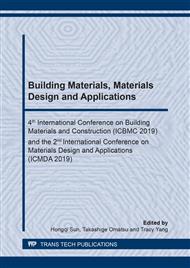p.141
p.148
p.159
p.165
p.172
p.178
p.185
p.191
p.203
Morphology, Mechanical and Thermal Properties of Poly(Lactic Acid)/Propylene-Ethylene Copolymer/Cellulose Composites
Abstract:
This work studied the effects of various types of cellulose fibers on the morphology, mechanical and thermal properties of poly(lactic acid) (PLA)/propylene-ethylene copolymer (PEC) (90/10 w/w) blends. The PLA/PEC blends before and after adding cellulose fibers were prepared by melt blending method in the internal mixer and molded by compression method. The morphological analysis observed that the presence of cellulose in PLA did not change the phase morphology of PLA, and PLA/cellulose composite surfaces were observed the cellulose fibers inserted in PLA matrix and fiber pull-out. The phase morphology of PLA/PEC blends was changed from brittle fracture to ductile fracture behavior and showed the phase separation between PLA and PEC phases. The presence of celluloses did not improve the compatibility between PLA and PEC phases. The tensile stress and strain curves found that the tensile stress of PLA was the highest value. The addition of all celluloses increased Young’s modulus of PLA. The PEC presence increased the tensile strain of PLA over two times when compared with neat PLA and PLA was toughened by PEC. The incorporation of cellulose fibers in PLA/PEC blends could improve Young’s modulus, tensile strength, and stress at break of the blends. The thermal stability showed that the degradation temperatures of all types of cellulose were less than the degradation temperatures of PLA. Thus, the incorporation of cellulose in PLA could not enhance the thermal stability of PLA composites and PLA/PEC composites. The degradation temperature of PEC was the highest value, but it could not improve the thermal stability of PLA. The incorporation of cellulose fibers had no effect on the melting temperature of the PLA blend and composites.
Info:
Periodical:
Pages:
172-177
Citation:
Online since:
October 2019
Price:
Сopyright:
© 2019 Trans Tech Publications Ltd. All Rights Reserved
Share:
Citation:


